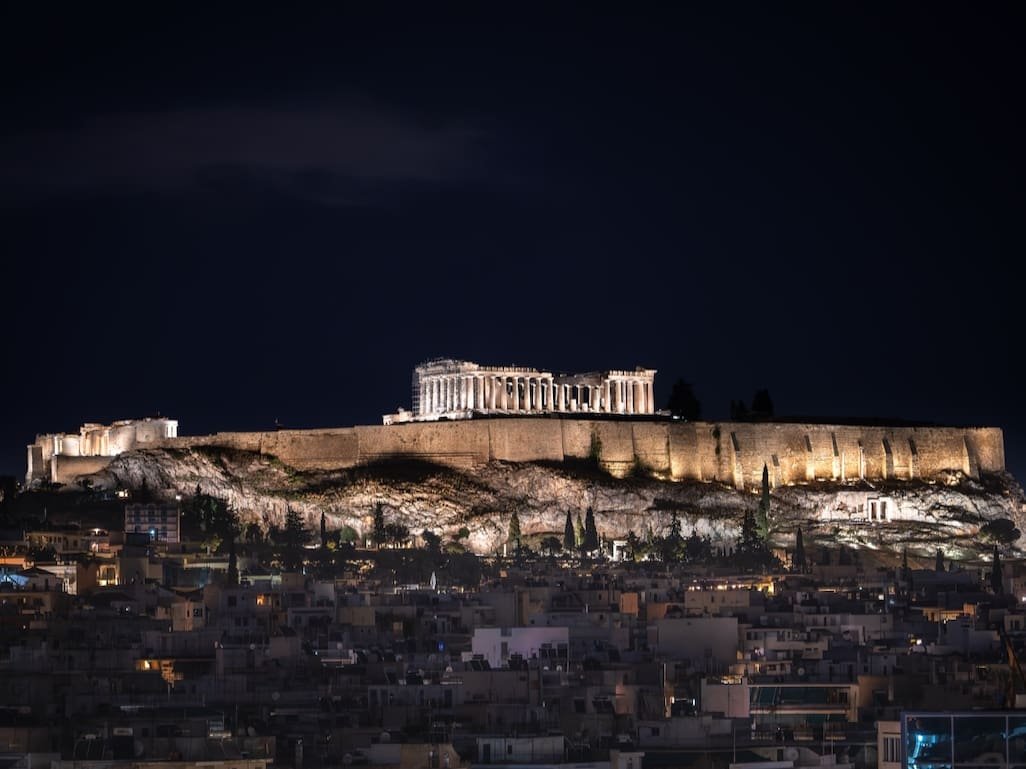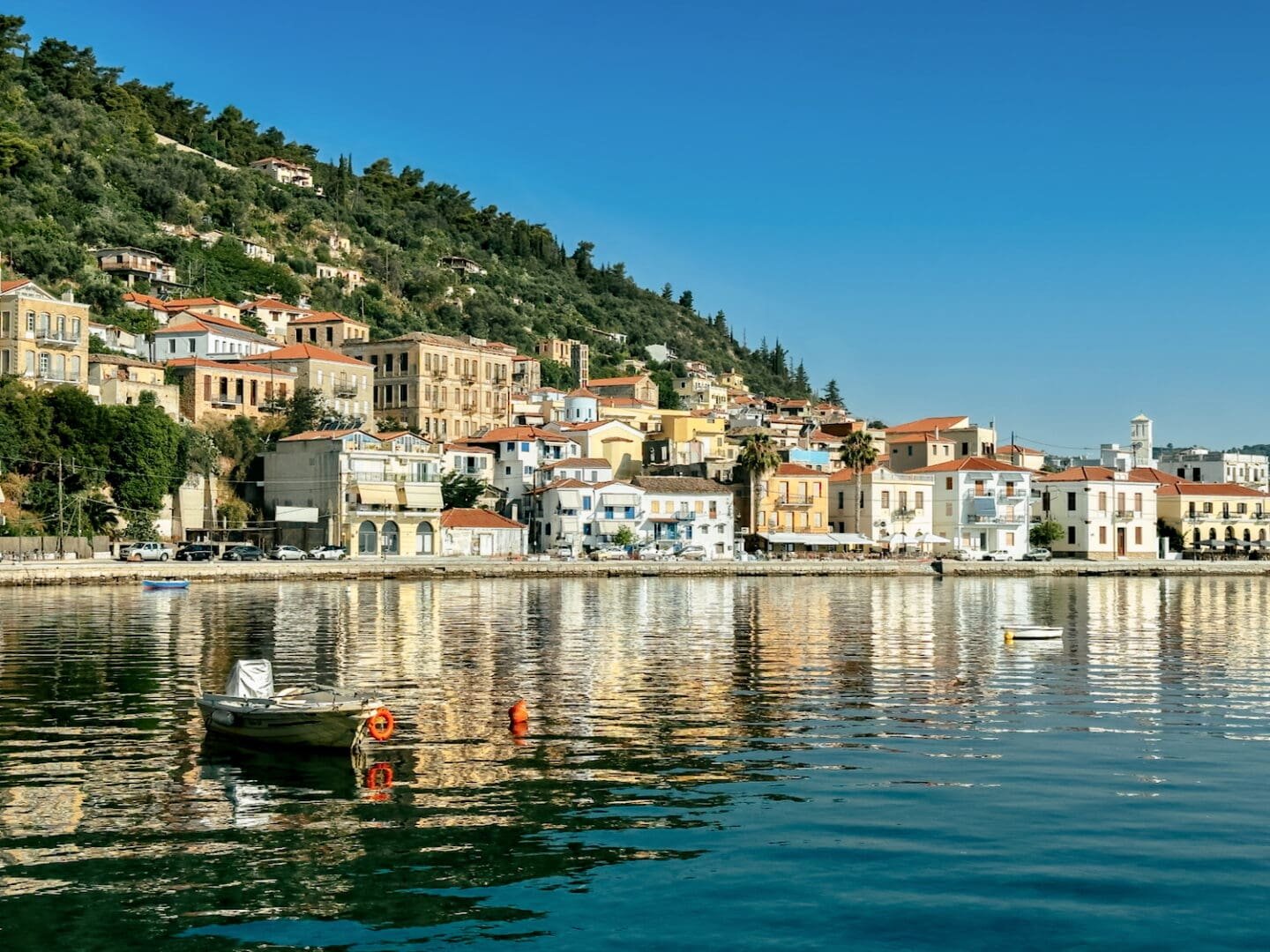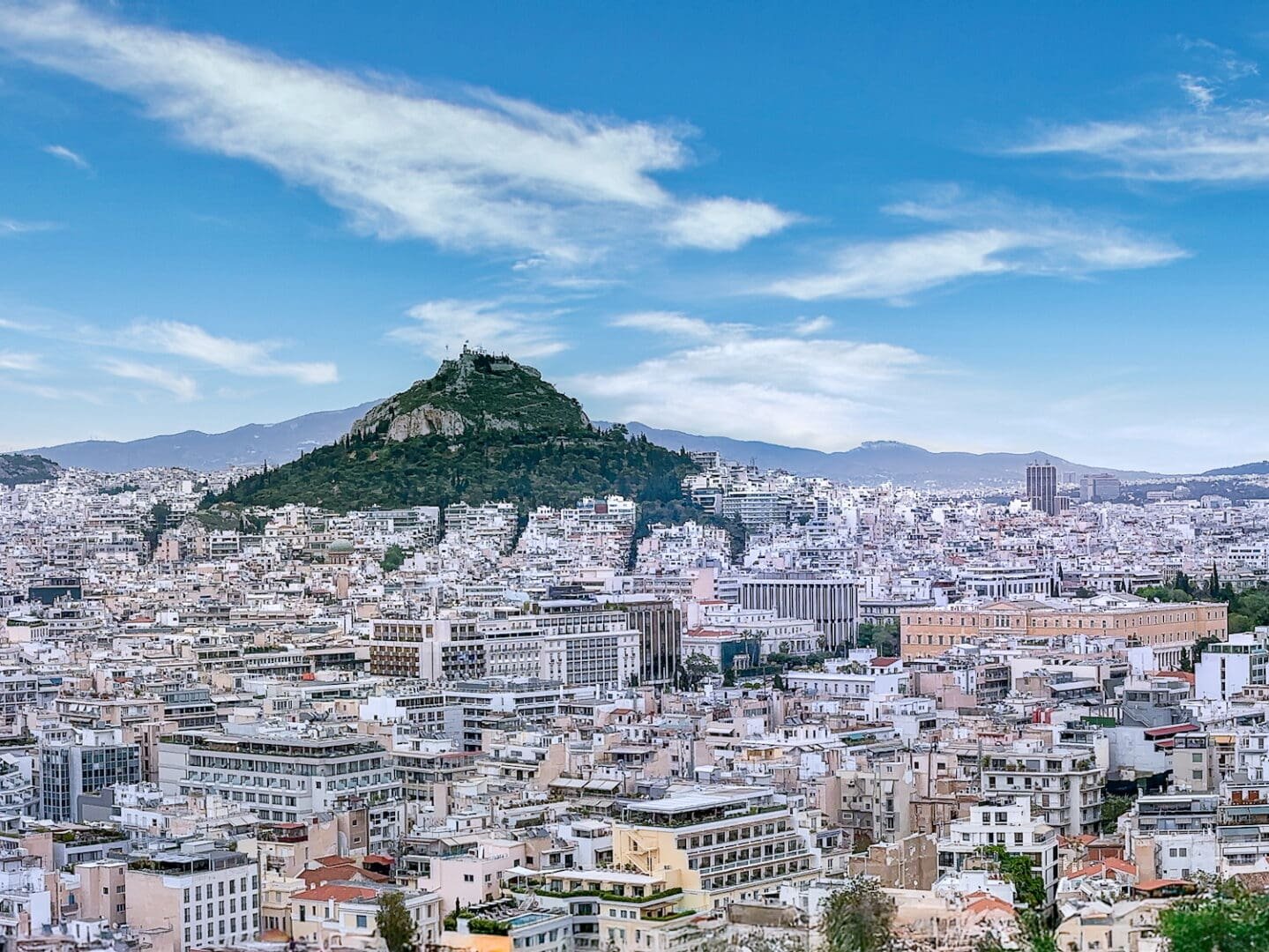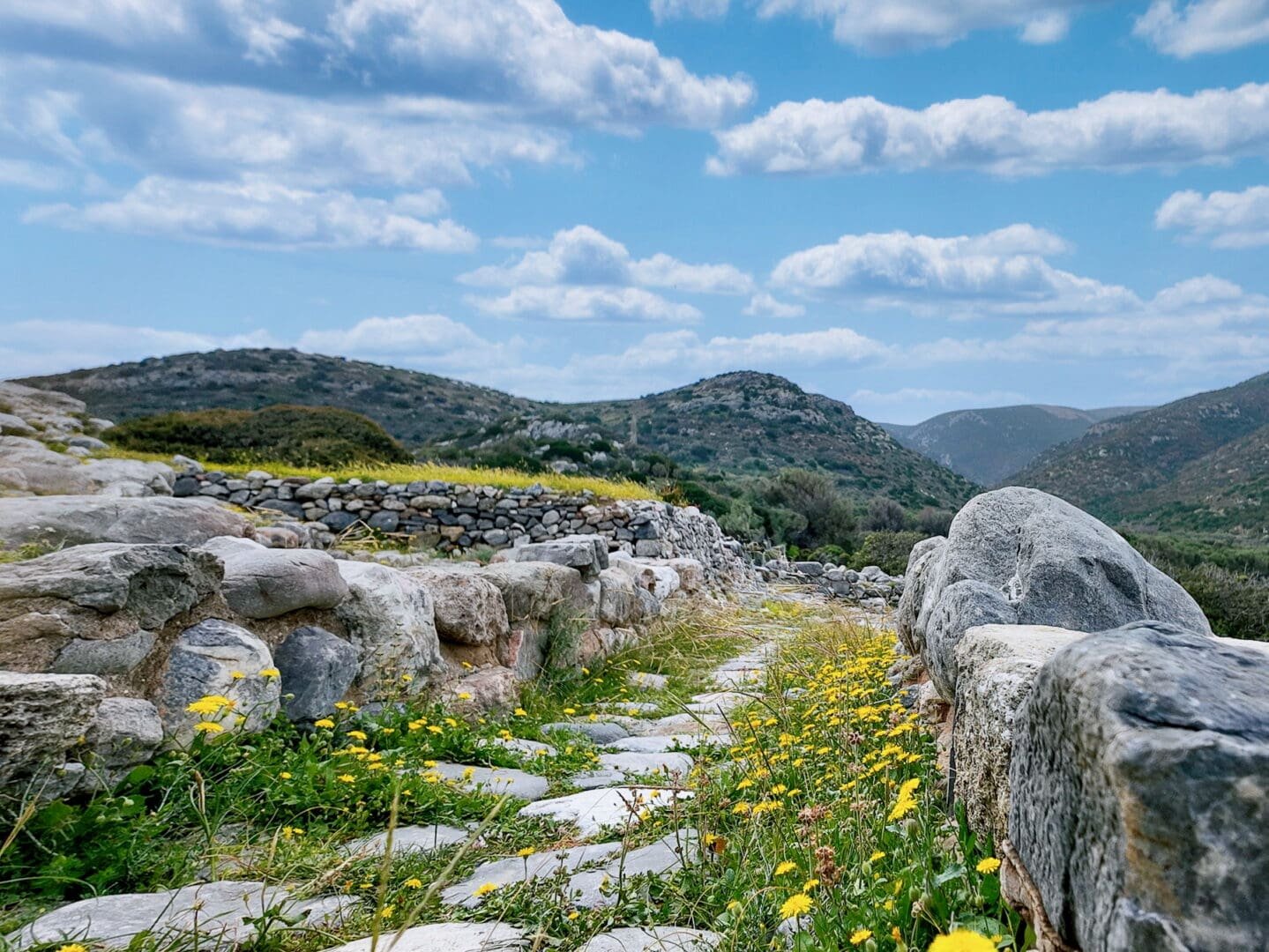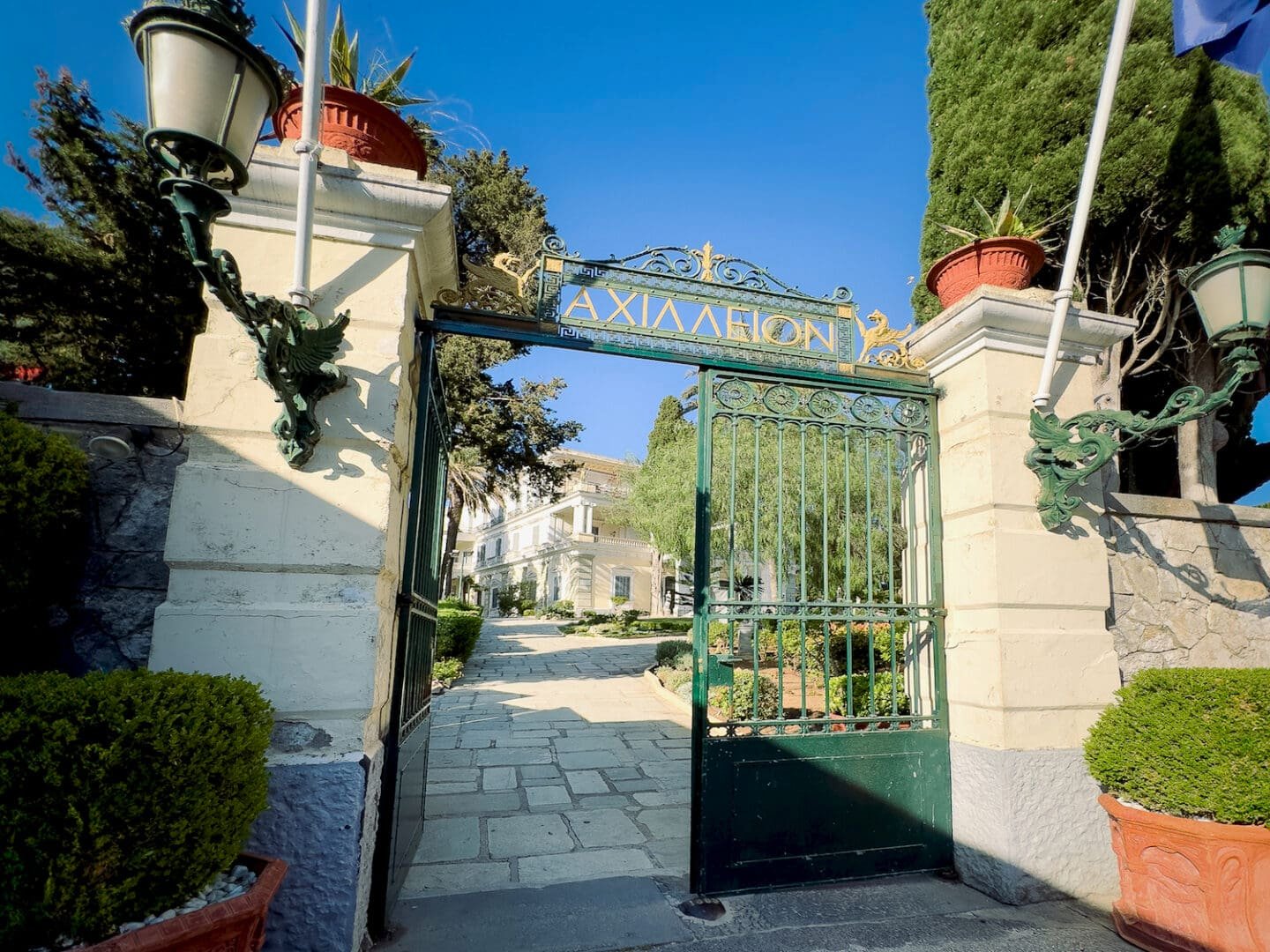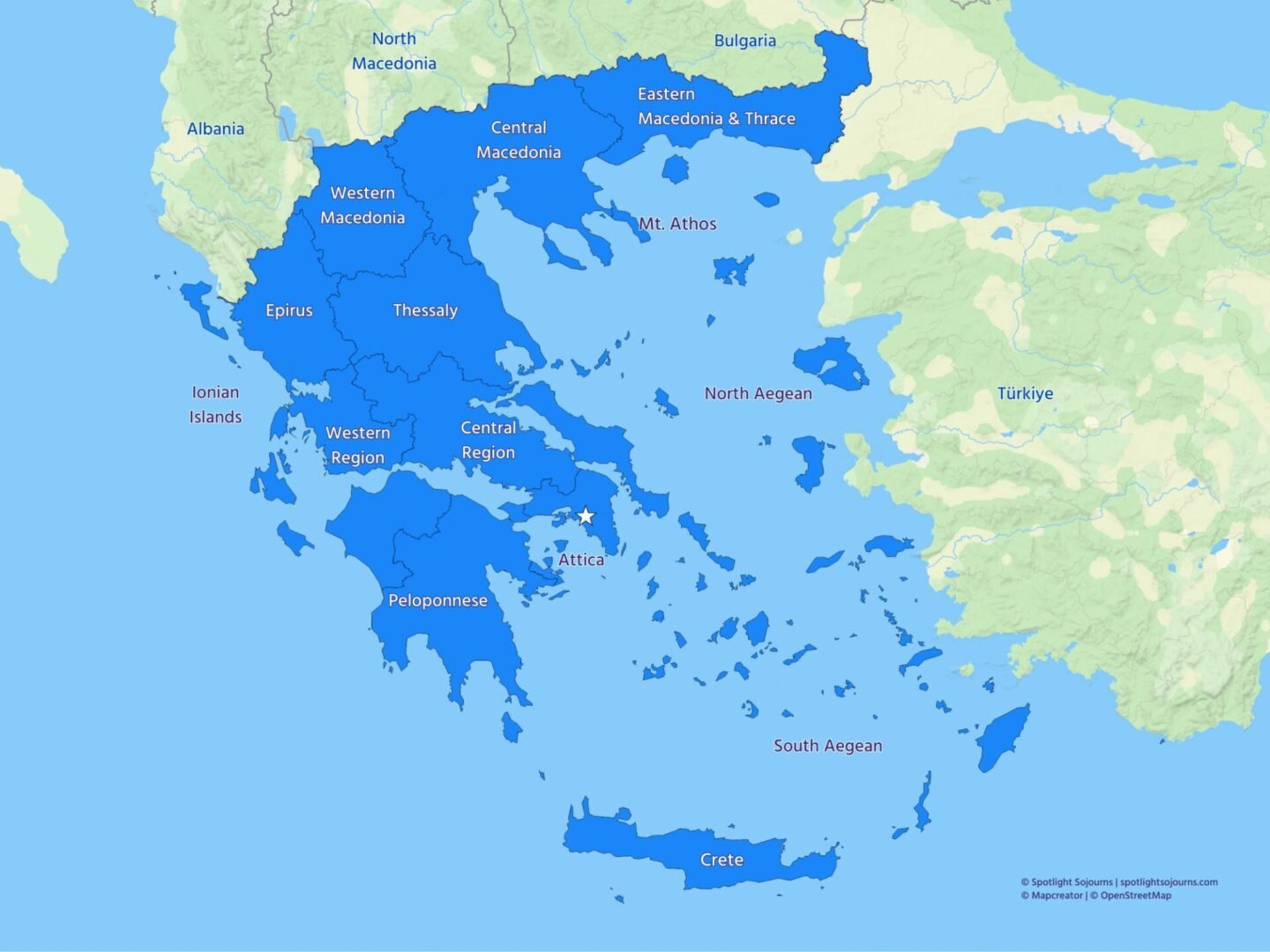
How many regions of Greece are there? What’s the difference between the Peloponnese peninsula and the Peloponnese Region? Where does Mount Athos fit into the regions in Greece?
These are all excellent questions about the Hellenic Republic (Ελληνική Δημοκρατία), the modern Greek nation today.
With a history spanning thousands of years from Ancient Greece to Modern Greece, the various names, definitions, delineations, and demarcations have changed over time.
So we’re here to help answer these questions for fellow wanderers. Because during years of slow travel in Greece, we’ve had firsthand experience with these occasionally confusing changes.
Paul, himself a native Hellene and former resident of Athens, is Spotlight Sojourns’ mapmaker, as well as photographer and FAA-certified, FAA-licensed drone pilot. You’ll find Paul’s custom maps throughout this article.
Ready? Πάμε, let’s go!
- Map of Greece and Islands
- 9 Things All Greek Regions Have in Common
- Map of Greece and Islands: Geographic Regions
- Geographic Regions in Greece
- Map of Greece and Islands: Administrative Regions
- Regions of Greece
- Attica, the 1st Region of Greece
- Central Greece, the 2nd Region in Greece
- Central Macedonia, the 3rd Region of Greece
- Crete, the 4th Region of Greece
- Eastern Macedonia and Thrace, the 5th Region of Greece
- Epirus, the 6th Region of Greece
- Ionian Islands, the 7th Region of Greece
- North Aegean, the 8th Region of Greece
- Peloponnese, the 9th Region of Greece
- South Aegean, the 10th Region of Greece
- Thessaly, the 11th Region of Greece
- Western Greece, the 12th Region in Greece
- Western Macedonia, the 13th Region in Greece
- Mount Athos, the 14th Region of Greece
- Interactive Map of Greece and Islands: Regional Capitals
- Check Out More Recommendations
- FAQs
When you book or purchase through some links, Spotlight Sojourns may earn a small commission at no extra cost to you. Thanks for using our affiliate links!
Map of Greece and Islands
As you can see in the Map of Greece and the Islands, the modern nation of Greece encompasses the Greek mainland, islands, and seas in Southern Europe.
The Greek mainland borders the Ionian Sea and Adriatic Sea on the west.
Next, the northern and eastern borders of mainland Greece share four international borders:
- Albania is on the northwest border.
- Bulgaria is on the north-central border.
- The Republic of North Macedonia (formerly the Yugoslav Republic of Macedonia) is on the northeast border.
- Türkiye is on the eastern border.
Then, the Peloponnese peninsula sets the southern border of continental Greece.
Additionally, thousands of Greek islands and islets fill the Ionian Sea, the Aegean Sea, and the Cretan Sea.
Lastly, the island of Crete forms not only the southernmost border of Greece but also the southernmost point of Europe.
9 Things All Greek Regions Have in Common
The whole of Greece, mainland, islands, and seas, totals 50,949 square miles (131,957 square kilometers) in southern Europe.
Whether we’re discussing geographic or administrative regions, every Greek region overall shares nine special attributes:
- Epic history from prehistoric, Ancient Greek and Roman eras, to Byzantine, Frankish, Venetian, and Ottoman Empires, and now the modern Greek nation.
- Longest coastlines in the Mediterranean Sea, between 8,500 and 9,400 miles (13,676 and 15,147 km) in total coastline length, to say nothing of rivers and lakeshores.
- Clear waters and beautiful beaches on lakes and seas.
- Rugged mountains and mountain ranges, in fact, roughly 80% of Greece is mountains.
- Rustic villages upholding their rural heritage and local handicrafts.
- Picturesque towns like Nafplio, the first capital of Greece in 1832, after Greek sovereignty.
- Lively urban areas and municipalities, with Athens, Thessaloniki, and Patras being the three major cities and largest metropolitan areas.
- Authentic hospitality and gastronomy that honors traditions even when creating fresh innovations.
- Archaeological sites, museums, performing arts, churches, and culture aplenty.
Throughout Greece, landmarks of history, culture, and nature await your discovery in this land of dazzling depth, breadth, and beauty.
Given that vast national bounty, we’ll note only one regional main attraction in this article.
(Because the definitive guide to famous Greek landmarks is another article. To that end, check out More Recommendations below.)
Most, although not all, of these “greatest hits” understandably date from ancient times and archaeological sites.
So we’ll further learn some contemporary “fascinating facts” about each Region of Greece.
The modern era generally starts in the 19th century, following independence from Ottoman rule.
But in this case, we’ll specifically focus on fun and fascinating facts from the 20th and 21st centuries.
Map of Greece and Islands: Geographic Regions
Geographic Regions in Greece
The Greek mainland and Greek islands traditionally comprise nine geographic regions.
Corresponding to the geographic Map of Greece and Islands as shown above, here are the nine geographic regions in English alphabetical order:
- Aegean Islands (Νησιά Αιγαίου)
- Central Greece (Στερεά Ελλάδα)
- Crete (Κρήτη)
- Epirus (Ήπειρος)
- Ionian Islands (Νησιά Ιόνια)
- Macedonia (Μακεδονία)
- Peloponnese (Πελοπόννησος)
- Thessaly (Θεσσαλία)
- Thrace (Θράκη)
During the late 1980s till the early 2010s, Prime Ministers and the Greek government began to reorganize these nine geographic areas into 14 administrative regions.
To clarify, yes, the official number is actually 14 regions, not 13 regions of Greece. We’ll soon explore the 14th region’s exclusive distinctions.
Now that we’ve discussed the historic and traditional geographic areas, let’s dive into the 14 official administrative regions of Greece.
Map of Greece and Islands: Administrative Regions
Regions of Greece
Mainland Greece and the Greek Islands encompass a total of 14 administrative Regions of Greece.
The Hellenic Republic government arranges these official regions in the following order:
- 1st Region of Attica (Αττική)
- 2nd Region of Central Greece (Στερεά Ελλάδα)
- 3rd Region of Central Macedonia (Κεντρική Μακεδονία)
- 4th Region of Crete (Κρήτη)
- 5th Region of Eastern Macedonia and Thrace (Ανατολική Μακεδονία και Θράκη)
- 6th Region of Epirus ((Ήπειρος)
- 7th Region of Ionian Islands (Νησιά Ιόνια)
- 8th Region of North Aegean (Βόρειο Αιγαίο)
- 9th Region of Peloponnnese (Πελοπόννησος)
- 10th Region of South Aegean (Νότιο Αιγαίο)
- 11th Region of Thessaly (Θεσσαλία)
- 12th Region of Western Greece (Δυτική Ελλάδα)
- 13th Region of Western Macedonia (Δυτική Μακεδονία)
- 14th Region of Mount Athos, the Holy Mountain (Άγιο Όρος)
Each Region of Greece has its own capital city at the regional level. And, of course, all regional capitals fall under the national capital of Greece, Athens.
These 14 Regions of Greece subsequently contain a total of 75 regional administrative districts.
The official term for these sub-regional areas is regional units (περιφερειακές ενότητες).
Special Note: Regions and regional units were formerly known as provinces and prefectures. You may still hear those terms; however, provinces and prefectures are no longer in official use.
Now, let’s start our easy overview of each region, both on and off the beaten path, in this endlessly intriguing country.
Attica, the 1st Region of Greece
The first Region of Greece, Attica (Αττική) is home to Athens, the national capital and the largest city in Greece.
The Attica Region and Athens, which is also the regional capital city, govern the following regional units:
- Central Athens (Κεντρικός Τομέας Αθηνών)
- North Athens (Βόρειος Τομέας Αθηνών)
- South Athens (Νότιος Τομέας Αθηνών)
- West Athens (Δυτικός Τομέας Αθηνών)
- Piraeus (Πειραιώς)
- East Attica (Ανατολική Αττική)
- West Attica (Δυτική Αττική)
- Islands of Attica (Περιφερειακή ενότητα Νήσων)
Spreading far beyond historic Central Athens, the Greater Athens Metropolitan Area sprawls across the booming suburbs of North, South, East, and West Athens.
The Greater Athens Metropolis extends to the Athens Riviera, the popular name of Attica’s swanky coastal areas.
The Attica Region includes the Saronic Islands and also some scattered islands off the Peloponnese’s southern Aegean coast.
Main Attraction: Region of Attica
Soaring above Central Athens is the eternal crowning glory of Greece, the Acropolis of Athens.
Below this iconic “high city,” dedicated since antiquity to the mythological goddess Athena, the Ancient Greeks built temples, theaters, agoras, schools, and workshops.
They developed and debated principles of philosophy, democracy, law, academia, and the arts.
The scholarly, democratic, artistic, and cultural creations of the Athenian Golden Age resonate to this very day.
Fascinating Facts: Region of Attica
According to the European Union (EU), Italy and Greece are the EU’s “two leading maritime passenger countries.”
In Greece, the majority of maritime passengers transit through the port of Piraeus.
Since antiquity, Piraeus has served as Athens’ port. Piraeus is thus the busiest and largest port on the Aegean Sea.
Not only is Piraeus a major international port for ferry boats and cruise ships, but it also ranks high in EU economic activity for commercial freight and container ships.
Seaborne transportation notwithstanding, in recent decades Piraeus has significantly grown from a seedy waterfront to the fourth-largest city in Greece.
Hundreds of thousands of people live, eat, and shop in neighborhoods of Piraeus. Attend church, go to school, play in parks, work in offices, and visit museums here.
Countless more people cheer their favorite professional teams, such as Olympiacos sports club, competing in Piraeus’ gleaming stadiums.
Central Greece, the 2nd Region in Greece
The second Region of Greece, Central Greece (Στερεά Ελλάδα) is fondly called Sterea Ellada, or “Solid Greece.”
The Central Greece Region and its regional capital, Lamia, administer the following regional units:
- Phthiotis (Φθιώτιδα)
- Boeotia (Βοιωτία)
- Euboea (Εὔβοια) or Evia
- Evrytania (Ευρυτανία)
- Phocis (Φωκίδα)
Sterea Ellada includes Greece’s second-largest island, Euboea, also spelled Evia in contemporary transliteration.
The regional unit Euboeau also incorporates the island of Skyros, some satellite islets, and a small mainland area.
Main Attraction: Region of Central Greece
Central Greece is blessed with several UNESCO World Heritage Sites. Yet undoubtedly the main attraction in Sterea Ellada is the Archaeological Site of Delphi.
Ancient peoples believed Delphi to be the literal “navel of the world,” i.e., the earth’s actual center.
Pilgrims traveled from far and wide to visit the sanctuary and consult the Oracle of Delphi.
Fascinating Facts: Region of Central Greece
The island of Euboea offers easy access via ferry or by car from Athens and mainland Greece. Surprisingly, Euboea remains refreshingly un-touristed and rather off the beaten track.
However, Euboea rolls out the red carpet when hosting the annual Evia Film Project.
Usually held in mid-to-late June, the Evia Film Project operates under the aegis of the globally acclaimed Thessaloniki Film Festival.
The Evia Film Project blends cinematic inspirations with creative initiatives. Festival programming brings international artists to local communities.
Central Macedonia, the 3rd Region of Greece
The third Region of Greece, Central Macedonia (Κεντρική Μακεδονία) holds the everlasting heart of Northern Greece.
Its regional capital, Thessaloniki, was founded in the early 4th century BC as the co-capital of the Byzantine Empire.
Thessaloniki still retains its long-time role as the co-capital of Greece. Second in size to Athens, Thessaloniki is a cultural powerhouse and a hub of economic activity, education, and innovation.
The Central Macedonia Region, the largest region by area, administers the following regional units:
- Thessaloniki (Θεσσαλονίκη)
- Chalkidiki (Χαλκιδική)
- Imathia (Ημαθία)
- Kilkis (Κιλκίς)
- Pella (Πέλλα)
- Pieria (Πιερία)
- Serres (Σέρρες)
Main Attraction: Region of Central Macedonia
Central Macedonia’s most famous attraction is Mount Olympus, where mists enshroud the celestial palaces of mythological gods.
Surely the Olympian gods chose Mount Olympus, being that it’s the highest mountain range in Greece, a land of mighty mountains.
In 1938, the Greek state designated Mount Olympus as the first national park. In 1981, Mount Olympus received recognition as one of the UNESCO World Biosphere Reserves in Greece.
Fascinating Facts: Region of Central Macedonia
The Region of Central Macedonia holds a variety of records, such as:
- On Mount Olympus, Mytikas is the highest mountain peak in Greece at 9,570 feet (2,917 meters).
- The Thessaloniki International Film Festival is the longest-running film festival in Greece (since 1960).
- Chalkidiki consistently has the greatest number of Blue Flag beaches of any Greek sub-region (93 awards in 2025).
Central Macedonia, or more precisely, a Central Macedonian person, holds a world record unlike any other and quite likely unbeatable:
In 2008, Mr. Pandelis Konstantinidis of Thessaloniki, Central Macedonia, Greece, set the record for “Longest Career as an Olympic Torchbearer.”
Guinness World Records certified Mr. Konstantinidis’ participation in Olympic torch relays over 72 years. Yes, you read that right, 72 years!
At age 19, Pandelis Konstantinidis first carried the torch during the inaugural Olympic torch relay for the 1936 Berlin Olympics.
He then participated in the 2004 Athens Olympics torch relay. Mr. Konstantinidis lastly carried the torch for the 2008 Beijing Olympics.
Crete, the 4th Region of Greece
The fourth Region of Greece, Crete (Κρήτη) is the largest island in Greece. Crete also ranks as the fifth-largest island in the entire Mediterranean Sea.
Heraklion, the regional capital, is the largest city on Crete and furthermore, on any Greek island.
The Crete Region administers the following regional units:
- Heraklion (Ηράκλειο)
- Chania (Χανιά)
- Lasithi (Λασίθι)
- Rethymno (Ρέθυμνο)
Main Attraction: Region of Crete
Among countless attractions on Crete, Knossos ranks number one. Knossos Palace, a palatial center of the Minoan civilization, is a 5,000-year-old attraction of worldwide fame.
Knossos, coupled with five other Minoan archaeological sites, achieved even more fame in 2025 as UNESCO World Heritage Sites.
Fascinating Facts: Region of Crete
Nature ranks among the best reasons to visit Greece, and Crete indisputably abounds in natural beauty.
Crete frequently wins the largest number of Blue Flag awards of all the Regions of Greece. In 2025, 153 beaches in Crete earned this elite international honor.
In addition, Crete boasts two of Greece’s UNESCO World Biosphere Reserves, the Asterousia Mountain Range and the Samaria Gorge.
Crete’s endless olive groves provided the majority of medalists’ olive wreaths at the Athens 2004 Summer Olympic Games.
Eastern Macedonia and Thrace, the 5th Region of Greece
The fifth Region, Eastern Macedonia and Thrace (Ανατολική Μακεδονία και Θράκη) honors the Balkan heritage of Northern Greece.
The Eastern Macedonia and Thrace Region and its regional capital, Komotini, administer the following regional units:
- Rhodope (Ροδόπη)
- Drama (Δράμα)
- Evros (Έβρου)
- Kavala (Καβάλα)
- Thasos (Θάσος)
- Xanthi (Ξάνθη)
Main Attraction: Region of Eastern Macedonia and Thrace
Dadia-Lefkimi-Soufli Forest National Park is a real draw of this rustic and rural region. The vast forests contain hundreds of species of flora, fauna, and birds. So many birds, in fact, it’s the “Land of the Birds of Prey.”
The national park additionally contains a rare petrified forest. The Lefkimi-Fylkato Fossilized Forest preserves fossils millions of years old in their original natural environment.
Fascinating Facts: Region of Eastern Macedonia and Thrace
During the 20th century, two Eastern Macedonia and Thrace communities dominated two important industries: Tobacco in the city of Kavala, and silk in the village of Soufli.
Presently, the elegant Kavala City Hall was once the grand neoclassical mansion of a tobacco titan.
Meanwhile, Soufli continues its silk industry. Indeed, UNESCO named Soufli the first Best Tourism Village in Greece for its ongoing commitment to sericulture.
Epirus, the 6th Region of Greece
The sixth Region of Greece, Epirus (Ήπειρος) celebrates Balkan culture in mountain villages and coastal communities.
The Epirus Region and its regional capital, Ioannina, administer the following regional units:
- Ioannina (Ιωάννινα)
- Arta (Άρτα)
- Preveza (Πρέβεζα)
- Thesprotia (Θεσπρωτία)
Main Attraction: Region of Epirus
Epirus’ paramount attraction is Vikos Gorge. It’s the world’s deepest canyon relative to width, according to the 1997 Guinness Book of World Records.
A commemorative sign on-site advises that Vikos Gorge is 2,950 feet (900 m) deep and only 3,600 feet (1,100 m) between its rims.
Even without Guinness‘ proclamation and measurements, the “Grand Canyon of Greece” is a sight of natural wonder and awe.
Fascinating Facts: Region of Epirus
Medieval Ioannina, one hand, reflects Balkan culture in its Byzantine and Ottoman history, architecture, and traditions.
Modern Ioannina, on the other hand, reveals a forward-looking focus. Since 1964, the University of Ioannina has attracted top students and scholars from Greece and Europe to the shores of Lake Pamvotida.
Founded in 1999, the Ioannina Science and Technology Park of Epirus attracts both multinational firms and start-ups alike.
All things considered, Ioannina is a rising digital economy and a tech hub popular with digital nomads.
Ionian Islands, the 7th Region of Greece
The seventh region of Greece, the Ionian Islands (Νησιά Ιόνια) is the smallest region in Greece by land area.
The Ionian Island Region and its regional capital, Corfu, administer the following regional units:
- Corfu (Κέρκυρα)
- Cephalonia (Κεφαλονιά), otherwise spelled Kefalonia
- Ithaca (Ιθάκη)
- Lefkada (Λευκάδα)
- Zakynthos (Ζάκυνθος)
Main Attraction: Region of Ionian Islands
Corfu Town is the premier tourist attraction of the Ionian Islands. Indeed, the entire historic city center is a UNESCO World Heritage Site.
The Old Fortress and other castles have protected Corfu as a city, island, and culture, distinctive as the “Door of Venice.”
Special Note: You may wonder when looking at maps, “Hmm, isn’t Kythira one of the Ionian Islands?” Well, yes, but with this caveat: Although Kythira is geographically located in the Ionian Sea, Kythira administratively belongs to the Attica Region.
Fascinating Facts: Region of Ionian Islands
The largest plateia or public square in Greece is in the Ionian Islands, that is, the Spianada in Old Town Corfu.
The Spianada features elegant arcades, neoclassical architecture, important monuments, small parks, and a huge grass lawn.
The Spianada’s huge lawn, however, is more than a lush green space. Because it’s the premier cricket pitch in Greece.
Corfiots have a long-standing passion for cricket, due to the British who brought the sport in the 19th century.
Today, the Hellenic Cricket Federation governs the sport in Greece. Here in Corfu Town, the federation oversees cricket competitions and clubs across Greece.
Representing Greece as a member of the International Cricket Council, the Hellenic Cricket Federation further organizes the national team for international cricket matches.
North Aegean, the 8th Region of Greece
The eighth Region of Greece, the North Aegean islands (Βόρειο Αιγαίο) dot the eastern Aegean Sea near the Turkish coast.
The North Aegean Region and its regional capital, Chios, administer the following regional units:
- Chios (Χίος)
- Ikaria (Ικαρία)
- Lemnos (Λῆμνος)
- Lesbos (Λέσβος)
- Samos (Σάμος)
Main Attraction: Region of North Aegean
Black volcanic stone beaches and golden sandy beaches are big draws in the North Aegean.
Still, the North Aegean Region offers an attraction that’s truly one of a kind. In other words, the mastic culture and medieval villages of Chios.
The clear resin droplets of mastic trees produce mastic chewing gum, mastic liqueur, and other mastic products.
Residents of the Mastichochoria, Chios’ mastic villages, maintain the priceless knowledge and painstaking handiwork to cultivate and produce mastic.
Chios mastic is an EU Protected Designation of Origin (PDO). Likewise, Chios mastic cultivation and production are part of Greece’s UNESCO Intangible Cultural Heritage.
Fascinating Facts: Region of North Aegean
Like olive oil, Greek wines have been inseparable from Greek life and Greek landscapes since, well, forever.
Similar to olive groves, vineyards grow almost everywhere in Greece. Terraced vineyards climb steep mountainous interiors. Long rows of vines march across valleys and plains.
Samos in particular produces renowned white wines from the Samos White Muscat or Moschato white grapes, also called Moschoudi and Muscat blanc à petits.
In 1937, Samos became the first Greek viticultural area to receive the European Protected Designation of Origin (PDO) for its unique terroir.
Peloponnese, the 9th Region of Greece
The ninth Region of Greece, Peloponnese (Πελοπόννησος) occupies a large swath of a legendary peninsula.
The Peloponnese Region and its regional capital, Tripoli, administer the following regional units:
- Arcadia (Αρκαδία)
- Argolis (Αργολίδα)
- Corinthia (Κορινθία)
- Laconia (Λακωνία)
- Messinia (Μεσσηνία)
Special Note: “Wait a minute,” you may be thinking. “Earlier, you said Patras is one of Greece’s three major cities. Patras is in the Peloponnese. So why is Tripoli the Peloponnese regional capital?” Now that’s a good question. So, here’s the answer:
Patras is located in the northern Peloponnese peninsula, assigned to the Western Greece Region. Hence, Tripoli is the capital of the Peloponnese Region.
Main Attraction: Region of Peloponnese
The Peloponnese Region offers a full spectrum of Greek experiences within driving distance of Athens:
Lovely long coastlines and majestic mountains. Vibrant towns and villages. Delectable food. And, of course, archaeological sites galore.
Amidst this abundance, the UNESCO World Heritage Site of Ancient Epidaurus arguably ranks as the ultimate attraction.
The foremost healing center in the Classical world, Epidaurus is also home to the Ancient Epidaurus Theatre. This extraordinary amphitheater is still used for summer performances.
Fascinating Facts: Region of Peloponnese
When the Corinth Canal opened at the dawn of the 20th century, it was a wonder of the modern world.
Over 130 years since its 1893 opening, the Corinth Canal remains a monument of national identity and pride. And, obviously, a favorite stop on school excursions and sightseeing tours.
The canal continues its original purpose as a short navigational waterway between the Ionian Sea and the Aegean Sea.
Comparatively, newer canals elsewhere in the world serve bigger ships. But the Corinth Canal still holds a Guinness World Record for the deepest canal.
South Aegean, the 10th Region of Greece
The tenth region of Greece, the South Aegean (Νότιο Αιγαίο) brings dreams of Greek isles to life.
The South Aegean Region and its regional capital, Ermoupoli, administer the following regional units:
- Syros (Σύρου)
- Andros (Άνδρος)
- Kalymnos (Κάλυμνος)
- Karpathos-Kasos (Κάρπαθος-Κάσος)
- Kea-Kythnos (Κέα-Κύθνος)
- Kos (Κως)
- Milos (Μήλος)
- Mykonos (Μύκονος)
- Naxos (Νάξος)
- Paros (Πάρος)
- Rhodes (Ρόδος)
- Thira (Θήρα), or Santorini (Σαντορίνη)
- Tinos (Τήνος)
Main Attraction: Region of South Aegean
The South Aegean Region boasts the top tourist destinations in the Greek islands: Santorini and Mykonos in the Cyclades, and Rhodes in the Dodecanese Islands.
This region and its many islands inspire artists, dreamers, and voyagers with their quintessential charms:
Little white houses and colorful bougainvillea blooms. Greek Orthodox churches with bright blue domes. Narrow alleys and knightly castles.
For the purpose of one main attraction in the South Aegean, it may entail a coin toss between two spectacular sights:
Either the breathtaking caldera, the volcanic crater of Santorini. Or the Grand Master’s Palace of the Knights Hospitaller, the UNESCO World Heritage castle city of Rhodes.
Fascinating Facts: Region of South Aegean
Ever since the Ancient Greek and Roman epochs, Greece and Italy have shared deep ties and intertwined relationships.
The international press has recently featured these Greek-Italian connections, for instance, on the Dodecanese island of Karpathos.
In 2022, National Geographic highlighted makarounes, the handmade pasta of Karpathos, and the “island’s hidden treasures.”
The National Geographic article also discussed the islanders’ thoughtful considerations before tourism overtakes their rather hidden gem.
In 2025, the Italian newspaperLa Republicca hailed the culture and gastronomy on Karpathos, “the island where time stands still” (“sull’isola dove il tempo si è fermato”).
The il Gusto article deliciously and explicitly heralded makarounes as the “Greek cavatelli” (I “cavatelli greci”).
Thessaly, the 11th Region of Greece
The eleventh Region of Greece, Thessaly (Θεσσαλία) is equally important for its pivotal place in present-day agriculture, as well as in mythology and history.
The Thessaly Region and its regional capital, Larissa, administer the following regional units:
- Larissa (Λάρισα)
- Karditsa (Καρδίτσα)
- Magnesia (Μαγνησία)
- Sporades Islands (Σποράδες)
- Trikala (Τρίκαλα)
Main Attraction: Region of Thessaly
Thessaly’s remarkable draw is Meteora, an awe-inspiring array of medieval monasteries. Each monastery perches alone atop a towering sandstone rock.
Starting in the 11th century, hermits first began to scale these singular peaks. Stone after stone, century after century, the monks built by hand a total of 24 monastic communities in the sky.
Many centuries later, the number of both pilgrims and tourists expanded exponentially when Meteora received UNESCO World Heritage recognition.
Fascinating Facts: Region of Thessaly
Six of the original 24 Meteora monasteries remain active, with at least one monk still in residence.
Surprisingly, one of the six monasteries of Meteora not only survives but also thrives as a female monastery.
In 1961, a small order of Greek Orthodox nuns obtained permission to move into the derelict 15th-century monastery of Agios Stephanos.
Six decades later, the restored Monastery of Saint Stephen now flourishes with an ever-growing religious community.
As one of the pioneering nuns told us, her sisterhood draws women of different ages and backgrounds to the monastic life of faithful service atop Meteora.
Western Greece, the 12th Region in Greece
The twelfth Region of Greece, Western Greece (Δυτική Ελλάδα) spans the western mainland, across the Gulf of Corinth, to the northern Peloponnese peninsula.
The Western Greece Region and its regional capital, Patras, administer the following regional units:
- Achaea (Αχαΐα)
- Aetolia-Acarnania (Αιτωλοακαρνανία)
- Elis (Ηλεία)
Main Attraction: Region of Western Greece
The champion attraction of Western Greece is Ancient Olympia, an archaeological site and UNESCO World Heritage Site of gold-medal quality.
Olympia is the original home of the Ancient Olympics, first held in 776 BC. Which is, of course, the original inspiration for the Modern Olympics, first held in 1896.
Fascinating Facts: Region of Western Greece
The art of Greek winemaking is ancient history. (literally!) Yet once upon a time, Greek wines were perhaps less respected than those of other wine regions.
The Bordeaux wine region of France comes to mind, for example. Or the California wine country of Sonoma and Napa Valley.
Slowly and surely, modern Greek winemakers have elevated their art in the vineyard, the barrel, the bottle, and the glass.
Today, sommeliers select Greek vintages for their wine lists. Luxury wine tours pair Greek wines with VIP experiences.
Some of these superior red and white wines come from the Western Greece regional unit of Achaea.
Since 1971, Achaea has earned the Protected Designation of Origin (PDO) for different viticultural areas.
The Achaean terroir of sea and mountain especially lends itself to naturally sweet wines, such as Mavrodaphni of Patras.
Mavrodaphni of Patras is nuanced, sophisticated, and beloved by both wine connoisseurs and casual wine drinkers.
Western Macedonia, the 13th Region in Greece
The thirteenth Region of Greece, Western Macedonia (Δυτική Μακεδονία) upholds the rich Balkan legacy of Northern Greece.
The Western Macedonia Region and its regional capital, Kozani, administer the following regional units:
- Kozani (Κοζάνη)
- Florina (Φλώρινα)
- Grevena (Γρεβενά)
- Kastoria (Καστοριά)
Western Macedonia is the only administrative region of Greece lacking sea access. However, its rivers and lake shores are peaceful and beautiful.
Main Attraction: Region of Western Macedonia
While we’re on the topic of Western Macedonia shorelines:
Lake Orestiada is a major draw for travelers who seek culture and/or nature off the beaten path. Not to mention snow, skiing, and other winter pursuits.
Kastoria, a charming Byzantine town, rises on the serene shores of Lake Orestiada. Chic ski resorts ring the surrounding mountains.
The lake of Kastoria is presently protected and improving as part of the European Natura 2000 network. The lake area is home to hundreds of species of flora, fauna, and especially birds.
When autumn turns to winter, migratory birds swell the local bird population. When the snow falls, local ski resorts open.
Local hotels accordingly fill with bird-watchers, skiers, and snowboarders. Winter is the peak season and thus considered the best time to visit here.
Fascinating Facts: Region of Western Macedonia
Greece shares international borders with Albania and the Republic of North Macedonia, among others, as shown above.
These international borders are chiefly land borders, and secondly, water borders. Because Greece, Albania, and the Republic of North Macedonia border the two Prespes lakes:
- Megali Lake Prespa or Greater Prespa Lake
- Mikri Prespa Lake or Small Prespa Lake
Little Prespa Lake has an inhabited island, Agios Achilleios or Saint Achilleios Island. For many generations, a few families have lived on this remote island.
For years, the island’s residents had requested a bridge so children and adults could safely cross Small Prespa Lake in winter. Their requests began with the local government, then moved to the regional level, and eventually, to the head of state.
At last, the islanders received a pontoon footbridge, one of the few floating bridges in Greece.
As a result, this little-known pedestrian bridge provides safe passage for both locals and visitors between the mainland and Saint Achillieos Island.
Special Note: Agios Achilleios in Small Prespa Lake is one of only two inhabited lake islands in Greece. Another inhabited lake island is To Nisi, the island of Lake Ioannina, Epirus.
Mount Athos, the 14th Region of Greece
The fourteenth Region of Greece, Mount Athos is the Holy Mountain (Άγιο Όρος), the world’s spiritual center of Orthodox Christian faith, history, and community.
Mount Athos’ regional capital is Karyes. The small community administers this religious district of international monasteries, monks, hermits, and pilgrims.
To clarify, the Mount Athos Region includes both the sacred mountain and the adjacent peninsula. A fence separates the Athonite peninsula from the Central Macedonia Region.
Main Attraction: Region of Mount Athos
The enduring attraction of Mount Athos is its monastic life, essentially unchanged for over 1,000 years.
Since the year 972, when Byzantine Emperor John I Tzimiskes signed its first constitution, the Holy Mountain has been a semi-autonomous monastic state.
Ten centuries later, the Hellenic Parliament specifically enshrined the semi-autonomous region and its ancient status in the Constitution of Greece.
Mount Athos is the only place on the global map that flies the flag of Byzantium. Where time follows the Julian calendar and the Byzantine clock.
And where neither males under age 18, unless with a father or guardian, nor females of any age, may set foot.
This follows Athonite law since the year 1066. And the Athonite tradition that the Holy Mother, together with St. John the Evangelist, once took shelter here in the 1st century AD.
Fascinating Facts: Region of Mount Athos
In 2011, Mount Athos invited the long-running and highly acclaimed CBS news show 60 Minutes to visit and film the Holy Mountain.
Award-winning journalist and 60 Minutes correspondent Robert Simon interviewed both senior Athonite leaders and also younger monks from different countries.
The 60 Minutes broadcast revealed to a worldwide audience the previously unseen treasures, timeless rituals, and meaningful stories of Mount Athos.
In short, Mount Athos, together with the late Bob Simon and 60 Minutes producers, made TV history.
Interactive Map of Greece and Islands: Regional Capitals
•••
Check Out More Recommendations
GET: Are you planning or dreaming of travel to Greece? Then get your exclusive free storytelling guide to tell your travel stories easily.
•••
FAQs
How many regions of Greece are there?
There are 14 administrative regions of Greece, starting with the 1st Region of Attica, and ending with the 14th Region of Mount Athos. Some references cite 13 regions of Greece to exclude Mount Athos, the Holy Mountain, which is a semi-autonomous monastic state. Besides these 14 official regions of Greece, there are 9 traditional geographic regions in Greece.
How many provinces in Greece are there?
Provinces and prefectures are terms no longer in official use by the Greek government. The official terms in use today are regions instead of provinces, and regional units rather than prefectures. At this time, there are 14 administrative regions and 75 regional units of Greece.
Does Greece have states?
Greece has an administrative structure of regions under the national government. The Greek regional structure differs from countries such as the USA, Australia, or Brazil, that have states under their national government.

All opinions expressed are Spotlight Sojourns’ own.
All content and images are original, created with care by yours truly, Marilee Kostadimas and Paul Kostadimas. We’re the Hidden Gemologists® of Spotlight Sojourns: Award-winning travel experts and slow travel storytellers. Because slow travel is meaningful travel, part of a meaningful life. And stories enrich the meaning.

